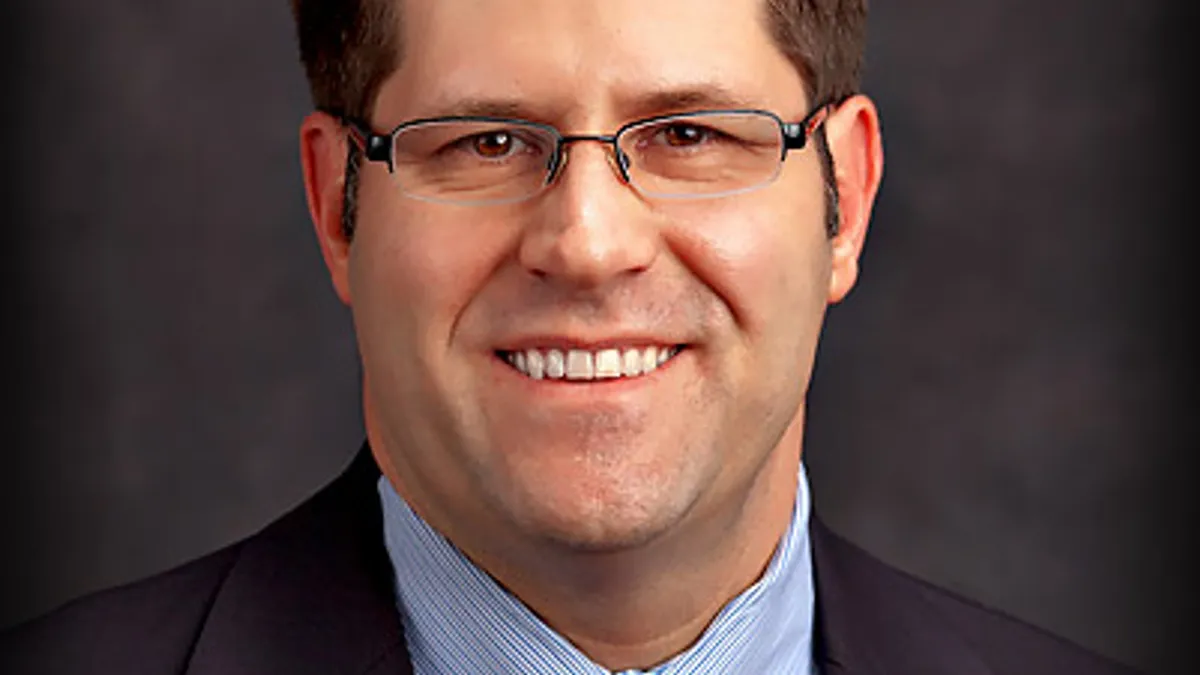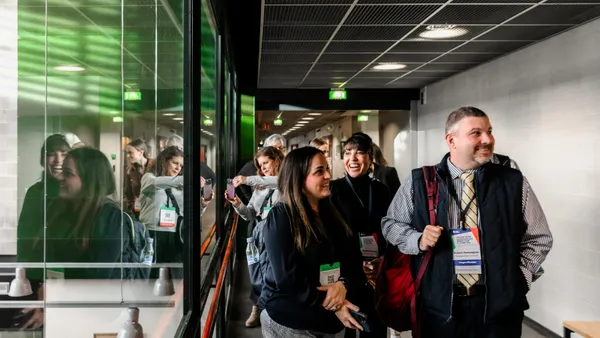Lessons In Leadership is an ongoing series in which K-12 principals and superintendents share their best practices and challenges overcome. For more installments, click here.
Owensboro Public Schools is one of only 10 districts recognized by Kentucky as a "District of Innovation," but the state's largest independent school district isn't without its challenges. The district serves a high-poverty student population, with about 73% of its 5,667 students on free-or-reduced lunch.
But it's also in a city on the rise, with a growing downtown that has proven popular among millennials. And Superintendent Nick Brake, who has led the district since 2013 and will leave the post at the end of December, played a role in that economic development growth before leading a number of district initiatives to blossom.
We recently caught up with Brake to learn more about the district's "Innovation" status and schools, CTE efforts, funding concerns and the importance of consistent leadership in success.
This interview was edited for brevity and clarity.
EDUCATION DIVE: What went into getting the "District of Innovation" recognition from the state, and what sort of opportunities did that open for the district?
NICK BRAKE: We got that designation in 2014, and we had applied previously and didn't get it. We initially had started to talk about using project-based learning embedded within some of our existing schools. That's where the split-screen approach [that helped win the distinction] came from. Traditional modes of education serve a lot of students well, so you don't necessarily have to reinvent [the model] for every student. The split-screen idea is that you throw it out and invite those that need to participate in that sector, and for everybody else, you have a traditional sector.
We opened the innovation [high school] academy in 2015 a class at a time. We'll be graduating our first class of students here in a month.
The middle school will open in the fall. We've got [around 300] students enrolled, and the affiliation with the New Tech Network [out of California] helps provide the support and the network of peers who do this sort of education, particularly the project-based education, to a level of rigor.
The high school we have is really shaped around career pathways. It's shaped around STEM. The middle school is going to be shaped more around global citizenship. We're in the process of re-upping on that [innovation] application for the middle school.
[The designation] has helped us in a couple of ways. We run the high school in conjunction with our county school district: We operate the school, but they can send students to it, as well, so it's a multi-district program. That's worked well for everybody because we have a great arts program that's in demand in our traditional high school.
Diverting some of our students into the STEM focus has allowed us to accept more students in the arts and expand that program and to really build up the performance spaces and do some of the kinds of things we want to do with those programs. I think it's helped to enhance the traditional and the innovation side of things.
Do you feel the "District of Innovation" recognition potentially makes it easier for Owensboro to share best practices with other districts?
BRAKE: That’s part of what we do in being part of that network, and that's valuable. It also allows us to work with the state in a special way to look at waivers and other things.
And while most of what we're doing with our programs doesn't really require special dispensation from the state, it does help provide us with that networking and with some of the ammunition we need to sort of throw out the old and do a redesign that's effective.
You previously worked on the city's economic development. Has that background helped as you've shaped everything from innovation schools and CTE programs to the arts programming you mentioned?
BRAKE: My path to this position was probably a little more of a nontraditional path. I worked in community economic development here and was involved in the emphasis we placed in Owensboro and the downtown development, which has helped our school district. It's really built the core of the city, and there's a lot of real estate demand that's helped fuel our tax base.
Independent school districts that are landlocked like ours around the state are not dealing with the same. They're dealing with the opposite. They're dealing with a declining tax base and declining population. And yet here we have a really vibrant core of our small city, with downtown housing.
Young people are coming here. Owensboro has been recognized as a top location for millennials, and that's been really healthy for us. It's been really good to have our strong city district as a complement to ... [what's] going on in the core of the city with the redevelopment of our downtown and our riverfront. We've been blessed to have strong board leadership over the years.
No independent district has a low tax rate because of all the things that I just mentioned, but we've been really blessed to have the support. And while we face challenges at the state and federal levels, it's, it's always an added benefit when you can go to the state and say, 'Look, our local folks are supporting our efforts.'
[My background] has played a significant role in everything, from the decision to do all-day preschool, which, from an economic development perspective, is some of the best money you can spend in public dollars. It inverts some of the negative ways you can spend public dollars.
Certainly, there are the CTE programs that need to align with the workforce — understanding what makes someone employable and the importance of alignment with postsecondary education like the early college academies that we have here. Speaking for our district and our county district, we’ll have 30-something kids in the two districts get their associate degree because of our early college academy.
Our community college is one of the few community colleges in the country that's in the demonstration project where the kids can get Pell money while they're still in high school. We have a lot of kids in dual-credit and in community college, and we really try to purposefully align our secondary programs to build in those postsecondary connections for as many students as we can — whether it's through CTE or traditional dual-credit or the associate’s degree.
Our high school graduation rates are above average [93.7% last school year], and our on-to-college rates are above average, but our degree attainment is below average. Some of that is availability of opportunity in the community and holding onto our college graduates or attracting new graduates from other locations.
But some of it is finding ways we can work together to better create those opportunities for students to jump right into college while they're still in high school.
Given the length of your tenure, how important is that sort of consistent, long-term leadership for district success?
BRAKE: It needs to be pointed out I inherited a really good district. Between my predecessor and his predecessors, we have a long history of good leadership here. That I think is, in and of itself, a motivator.
We've worked really hard on a leadership pipeline. We’re involved with the project at Western Kentucky University and the Wallace Foundation, the principal pipeline. We've worked to try to create a bench for future leaders. Having that leadership stability and having a good group of principals and central office leadership to work with … is huge because of the turnover rates and because of the fact that there's a lot of challenges in these positions.
Creating that uniformity of leadership and that long-term perspective is important. Building on some areas where my predecessor did a great job is important to do, but also making your own imprint [is important]. For example, with the innovation schools. Hopefully the person that takes my place will build on those and then put their own imprint so they have that kind of continuity.
I think it's an appealing district because of the financial stability, because of the fact that it's a strong community and a strong district, and it has a little bit of something for everybody. That has a lot of curb appeal for leadership. I wish district leadership positions were all that way, but we're really blessed here with what we have.













